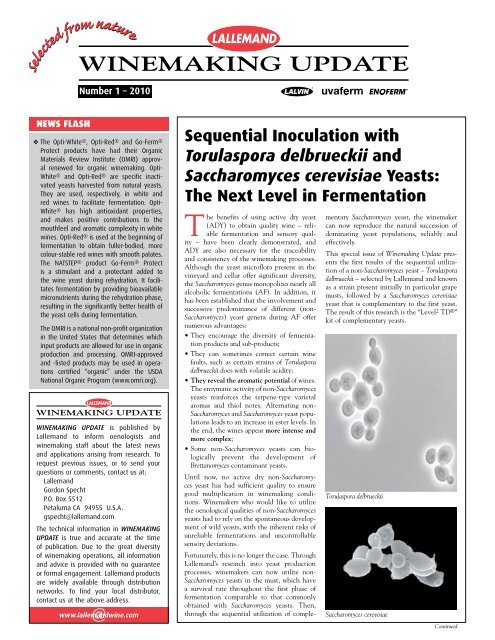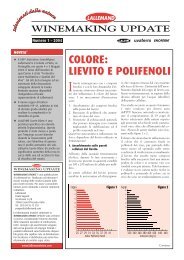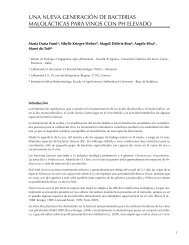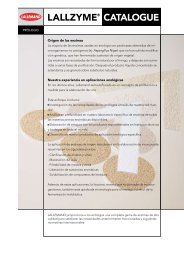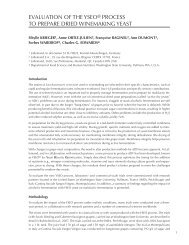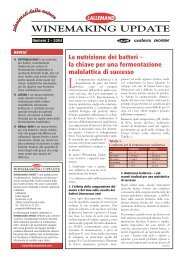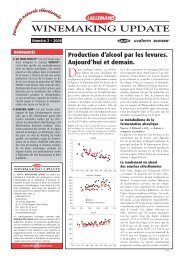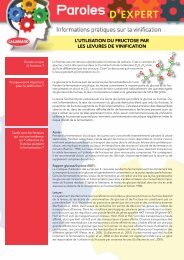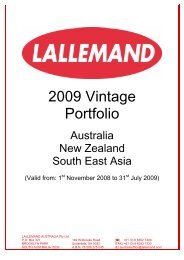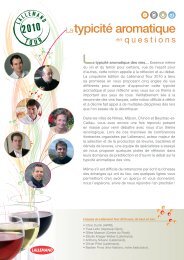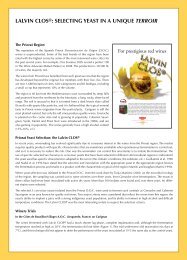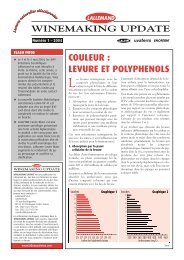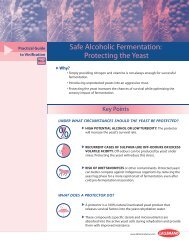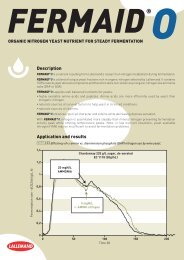WINEMAKING UPDATE - Lallemand Wine
WINEMAKING UPDATE - Lallemand Wine
WINEMAKING UPDATE - Lallemand Wine
Create successful ePaper yourself
Turn your PDF publications into a flip-book with our unique Google optimized e-Paper software.
<strong>WINEMAKING</strong> <strong>UPDATE</strong><br />
Number 1 – 2010<br />
NEWS FLASH<br />
❖ The Opti-White ® , Opti-Red ® and Go-Ferm ®<br />
Protect products have had their Organic<br />
Materials Review Institute (OMRI) approval<br />
renewed for organic winemaking. Opti-<br />
White ® and Opti-Red® are specific inactivated<br />
yeasts harvested from natural yeasts.<br />
They are used, respectively, in white and<br />
red wines to facilitate fermentation. Opti-<br />
White ® has high antioxidant properties,<br />
and makes positive contributions to the<br />
mouthfeel and aromatic complexity in white<br />
wines. Opti-Red ® is used at the beginning of<br />
fermentation to obtain fuller-bodied, more<br />
colour-stable red wines with smooth palates.<br />
The NATSTEP ® product Go-Ferm® Protect<br />
is a stimulant and a protectant added to<br />
the wine yeast during rehydration. It facilitates<br />
fermentation by providing bioavailable<br />
micronutrients during the rehydration phase,<br />
resulting in the significantly better health of<br />
the yeast cells during fermentation.<br />
The OMRI is a national non-profit organization<br />
in the United States that determines which<br />
input products are allowed for use in organic<br />
production and processing. OMRI-approved<br />
and -listed products may be used in operations<br />
certified “organic” under the USDA<br />
National Organic Program (www.omri.org).<br />
<strong>WINEMAKING</strong> <strong>UPDATE</strong><br />
<strong>Wine</strong>making update is published by<br />
<strong>Lallemand</strong> to inform oenologists and<br />
winemaking staff about the latest news<br />
and applications arising from research. To<br />
request previous issues, or to send your<br />
questions or comments, contact us at:<br />
<strong>Lallemand</strong><br />
Gordon Specht<br />
P.O. Box 5512<br />
Petaluma CA 94955 U.S.A.<br />
gspecht@lallemand.com<br />
The technical information in <strong>Wine</strong>making<br />
update is true and accurate at the time<br />
of publication. Due to the great diversity<br />
of winemaking operations, all information<br />
and advice is provided with no guarantee<br />
or formal engagement. <strong>Lallemand</strong> products<br />
are widely available through distribution<br />
networks. To find your local distributor,<br />
contact us at the above address.<br />
www.lallemandwine.com @<br />
Sequential Inoculation with<br />
Torulaspora delbrueckii and<br />
Saccharomyces cerevisiae Yeasts:<br />
The Next Level in Fermentation<br />
The benefits of using active dry yeast<br />
(ADY) to obtain quality wine – reliable<br />
fermentation and sensory quality<br />
– have been clearly demonstrated, and<br />
ADY are also necessary for the traceability<br />
and consistency of the winemaking processes.<br />
Although the yeast microflora present in the<br />
vineyard and cellar offer significant diversity,<br />
the Saccharomyces genus monopolizes nearly all<br />
alcoholic fermentations (AF). In addition, it<br />
has been established that the involvement and<br />
successive predominance of different (non-<br />
Saccharomyces) yeast genera during AF offer<br />
numerous advantages:<br />
• They encourage the diversity of fermentation<br />
products and sub-products;<br />
• They can sometimes correct certain wine<br />
faults, such as certain strains of Torulaspora<br />
delbrueckii does with volatile acidity;<br />
• They reveal the aromatic potential of wines.<br />
The enzymatic activity of non-Saccharomyces<br />
yeasts reinforces the terpene-type varietal<br />
aromas and thiol notes. Alternating non-<br />
Saccharomyces and Saccharomyces yeast populations<br />
leads to an increase in ester levels. In<br />
the end, the wines appear more intense and<br />
more complex;<br />
• Some non-Saccharomyces yeasts can biologically<br />
prevent the development of<br />
Brettanomyces contaminant yeasts.<br />
Until now, no active dry non-Saccharomyces<br />
yeast has had sufficient quality to ensure<br />
good multiplication in winemaking conditions.<br />
<strong>Wine</strong>makers who would like to utilize<br />
the oenological qualities of non-Saccharomyces<br />
yeasts had to rely on the spontaneous development<br />
of wild yeasts, with the inherent risks of<br />
unreliable fermentations and uncontrollable<br />
sensory deviations.<br />
Fortunately, this is no longer the case. Through<br />
<strong>Lallemand</strong>’s research into yeast production<br />
processes, winemakers can now utilize non-<br />
Saccharomyces yeasts in the must, which have<br />
a survival rate throughout the first phase of<br />
fermentation comparable to that commonly<br />
obtained with Saccharomyces yeasts. Then,<br />
through the sequential utilization of complementary<br />
Saccharomyces yeast, the winemaker<br />
can now reproduce the natural succession of<br />
dominating yeast populations, reliably and<br />
effectively.<br />
This special issue of <strong>Wine</strong>making Update presents<br />
the first results of the sequential utilization<br />
of a non-Saccharomyces yeast – Torulaspora<br />
delbrueckii – selected by <strong>Lallemand</strong> and known<br />
as a strain present initially in particular grape<br />
musts, followed by a Saccharomyces cerevisiae<br />
yeast that is complementary to the first yeast.<br />
The result of this research is the “Level 2 TD ® ”<br />
kit of complementary yeasts.<br />
Torulaspora delbrueckii<br />
Saccharomyces cerevisiae<br />
Continued
dCO 2 /dt (g/L.h)<br />
1.6<br />
1.4<br />
1.2<br />
1<br />
0.8<br />
0.6<br />
0.4<br />
0.2<br />
Fermaid E Nutrient Addition<br />
Saccharomyces cerevisiae<br />
inoculation<br />
0<br />
0 50 100 150 200 250<br />
Time (hours)<br />
Figure 1. Fermentation rate of Maccabeu must (sugars 240 g/L; turbidity 44 NTU, TA 2.10<br />
g/L H 2 SO 4 , pH 3.86) with sequential inoculation of Level 2 TD ® and a control with<br />
Saccharomyces cerevisiae active dry yeast<br />
Sequential inoculation with<br />
Torulaspora delbrueckii<br />
followed 48 hours later by<br />
Saccharomyces cerevisiae<br />
Saccharomyces cerevisiae<br />
inoculation<br />
1. Sequential inoculation<br />
It is generally accepted that the utilization<br />
of non-Saccharomyces yeasts in a monoculture<br />
does not permit the completion of fermentation<br />
(residual sugar < 2 g/L) within a reasonable<br />
timeframe compatible with the requirements<br />
of current winemaking techniques, while<br />
guaranteeing the absence of sensory faults.<br />
Under oenological conditions, these species<br />
have limited fermentation capacities compared<br />
to Saccharomyces yeasts, due notably to their<br />
weak capacity to multiply and to their particular<br />
needs for micronutrients and oxygen.<br />
It has been widely described that the succession<br />
of yeast populations, with the alternating<br />
domination of non-Saccharomyces yeasts in the<br />
first phase of alcoholic fermentation followed<br />
by Saccharomyces, is important to the aromatic<br />
complexity of wines (Zironi et al. 1993, Ferraro<br />
et al. 2000). In previous research (Languet et<br />
al. 2005), it was validated that the reproduction<br />
of the population dynamics of the yeasts with<br />
sequential inoculation, such as obtained with<br />
this T. delbrueckii, was the key to complexity.<br />
Although sequential inoculation is more restrictive<br />
than mixed inoculation in terms of oenological<br />
practices, two successive inoculations<br />
have proven to be indispensable to reproduce<br />
that in which nature often excels.<br />
The large-scale production of pure T. delbrueckii<br />
yeast in an active dry form, which presents sufficient<br />
capacity for survival and multiplication<br />
to meet the prime reliability criteria that is the<br />
implantation of a selected non-Saccharomyces<br />
yeast during the first phase of fermentation,<br />
has been the focus of <strong>Lallemand</strong>’s research and<br />
development for the past five years.<br />
Ester Composition of <strong>Wine</strong>s<br />
Ethyl caprylate (octanoate)<br />
Pineapple, pear<br />
Level 2 TD® process<br />
Control<br />
Ethyl 2-methyl butyrate<br />
Sweet fruit, blueberry<br />
Ethyl isobutyrate<br />
Citrus, strawberry<br />
Ethyl propionate<br />
Fruity, rum<br />
0 1 2 3 4 5 6 7 8 9 10 11 12 13 14<br />
Number of olfactory units<br />
Other Aromatic Molecule Composition of the <strong>Wine</strong>s<br />
2-phenylethanol<br />
Rose<br />
Level 2 TD® process<br />
Control<br />
Linalool<br />
Citrus, Rose<br />
0 2 4 6 8 10 12 14 16 18 20 22 24 26 28 30 32 34 36 38 40 42 44 46 48 50 52 54 56 58 60<br />
Number of olfactory units<br />
Figures 2a and 2b. Chardonnay: Number of olfactory units (concentration / perception threshold ratio) for different aromatic molecules in each wine after<br />
malolactic fermentation
After repeatedly optimizing the production processes,<br />
high quality active dry T. delbrueckii yeast<br />
was obtained. Its performance as a complement<br />
to a S. cerevisiae yeast was measured to ensure<br />
that the duo – later named Level 2 TD ® – was<br />
reliable during fermentation. For example, in<br />
Figure 1, the fermentation kinetics are maintained<br />
with the sequential inoculation (Level 2<br />
TD® – T. delbrueckii and S. cerevisiae) compared<br />
to a traditional S. cerevisiae yeast in active dry<br />
form.<br />
2. Aromatic complexity<br />
Several cellar trials were required to validate<br />
not only the sequential inoculation process with<br />
Level 2 TD® itself, but also to measure the sensory<br />
impact of a sequential inoculation on different<br />
musts and in different conditions. These<br />
trials were conducted over more than five years.<br />
2.1 For example, a must from a vineyard producing<br />
Chardonnay in 2008 in the Mâcon<br />
Village appellation in France showed little<br />
observable difference on the course of AF or<br />
the analysis, including the level of volatile acidity.<br />
The control yeast seems to have produced<br />
more SO 2 .<br />
On the other hand, the analyses of the aroma<br />
compounds revealed important differences<br />
(Figure 2a and 2b)<br />
Esters: As soon as the AF was complete, the<br />
trial wine presented significantly higher values<br />
than the control wine for ethyl hexanoate and<br />
ethyl butyrate, which increase the fruity perception.<br />
After the malolactic fermentation (MLF),<br />
the levels of these compounds decreased.<br />
However, the aroma losses were markedly less<br />
in the wine fermented sequentially.<br />
Terpenes: After AF, the linalool levels (lemon,<br />
rose) and 2-phenylethanol (floral notes) were<br />
higher in the wine fermented with Level 2 TD ® .<br />
As for the esters, this gap is reinforced after<br />
MLF.<br />
After MLF, a panel of consumers clearly preferred<br />
the wine fermented sequentially with<br />
Level 2 TD® (Figure 3). This wine was perceived<br />
as having superior aromatic complexity.<br />
Some tasters noted the presence of the “pastry”<br />
aroma range in this wine, which no one had<br />
Ranking the Two <strong>Wine</strong>s<br />
detected in the control wine.<br />
2.2 In another trial carried out on a Maccabeu,<br />
and following the same procedures (control<br />
yeast compared to sequential inoculation with<br />
Level 2 TD®), the AF proceeded correctly, with<br />
a slightly shorter lag phase in the must inoculated<br />
with T. delbrueckii. Analysis revealed<br />
a volatile acidity level clearly lower in the<br />
lot inoculated sequentially. Descriptive sensory<br />
analysis carried out with a panel of 14 tasters<br />
one month after bottling revealed important<br />
differences between the two wines (Figure 4).<br />
The trial wine presents aromatic intensities<br />
that are significantly higher than those of the<br />
control wine.<br />
Animal<br />
Fault<br />
Sensory Profile<br />
Aroma intensity / Nose<br />
5<br />
3<br />
1<br />
3. Promising results for lowering<br />
volatile acidity<br />
The utilization of certain strains of T. delbrueckii<br />
in sequential inoculation in the fermentation<br />
of late-harvest grape must seems to give particularly<br />
interesting results, not only in aromatic<br />
terms, but in terms of lowering volatile acidity<br />
as well, which is often a problem in this type of<br />
fermentation. Trials in Sauternes (France) on a<br />
Sémillon grape must with an alcohol potential<br />
of 21.4% showed that the sequentially inoculated<br />
lot was twice as low in volatile acidity as the<br />
classically fermented lot (0.35 g/L to 0.7 g/L).<br />
4. Testimony of cellar trial<br />
results<br />
The oenologists Tomaz Vieira da Cruz and<br />
Bernardo Magalhães, from the Alentejo region<br />
of Portugal, carried out winemaking in 2008 at<br />
the Encostas de Estremoz vineyard with T. delbrueckii,<br />
utilizing it sequentially with S. cerevisiae.<br />
They commented that:<br />
“The Portuguese varietals are not aromatic by<br />
nature, even less so when they are grown in<br />
hot regions like Alentejo. Their strong point is<br />
the structure and the mouthfeel which, when<br />
combined with good winemaking practices, can<br />
lead to fine, elegant wines. With good practices<br />
in the vineyard and some help from nature,<br />
these wines can present balanced acidity, in a<br />
natural way.<br />
“The aromatic component is the most problematic<br />
point. The radical use of such techniques<br />
as fermenting at very low temperatures, overclarifying<br />
the must and utilizing yeasts characterized<br />
as freeing certain types of aromas can<br />
result in wines with little structure, little body<br />
and incoherent ‘artificial’ aromas that are too<br />
unstable over time.<br />
“The aim of introducing Torulaspora to the fermentation<br />
process was to develop more overall<br />
sensory complexity. From a sensory point of view,<br />
a major difference was noted in the finesse and<br />
elegance of the aroma of the trial wine obtained<br />
by sequential inoculation, compared to the control<br />
made with Saccharomyces alone. What stand<br />
out in the trial wine are the pineapple aromas,<br />
which improve with time. Two months after the<br />
initial tasting, this note was not clear, one month<br />
later it was subtle, and now it is outstanding. On<br />
the palate, this aroma helps improve the freshness<br />
of the wine, by giving the mouthfeel a note<br />
of liveliness.”<br />
References available on request.<br />
Fresh fruit<br />
Floral<br />
Level 2 TD® process<br />
Control<br />
12<br />
Level 2 TD® process<br />
Number of tasters<br />
who gave higher ranking<br />
10<br />
8<br />
6<br />
4<br />
2<br />
Control<br />
Balsamic<br />
/ Woodsy<br />
Buttery / Milky<br />
Dried fruit<br />
Mineral<br />
Herbaceous<br />
0<br />
Figure 3. Preferences for the trial wines after MLF,<br />
judged by a consumer panel<br />
Figure 4. Sensory analysis of two Maccabeu wines one month after bottling, by a panel of 14 professional<br />
tasters.<br />
Continued
Figure 5.<br />
Level2 TD® process on white must<br />
Limitation: Free SO 2 < 20 mg/L<br />
Initial Density<br />
First level:<br />
Inoculation with<br />
Torulaspora<br />
delbrueckii<br />
!<br />
Important point:<br />
Rehydration protocol:<br />
different temperature<br />
from classic yeast (30°C)<br />
Initial Density<br />
– 10/15 points<br />
Second level:<br />
Inoculation with<br />
Saccharomyces<br />
cerevisiae<br />
!<br />
Important points:<br />
- Timing of inoculation<br />
- Classic rehydration protocol (37°C)<br />
- Yeast protection if necessary<br />
Immediately after second level:<br />
Systematically add complementary<br />
nutrient complex<br />
(30 mg/L available nitrogen)<br />
Initial Density – 45 points:<br />
If necessary, add complementary<br />
nutrient complex (according to the<br />
initial lack of nitrogen in the must)<br />
To summarize...<br />
The Level2 TD® kit includes the qualitative selection of Torulaspora delbrueckii yeast and complementary Saccharomyces cerevisiae yeast. The first yeast is<br />
inoculated into the must (the first level) then, after a loss of density of about 15 points, the second yeast is inoculated into the must (the second level).<br />
The qualitative impact on wines – an increase in quality, aromatic intensity and complexity, and mouthfeel – is optimized and preserved through a<br />
proactive set of actions in the cellar.<br />
The Level 2 TD® kit reveals particular ranges of aromas that enhance the wines, differentiating them from those obtained through conventional yeasts.<br />
<strong>Wine</strong>makers now have a new option to master the quality of their wines.<br />
For further information, contact your <strong>Lallemand</strong> advisor.


